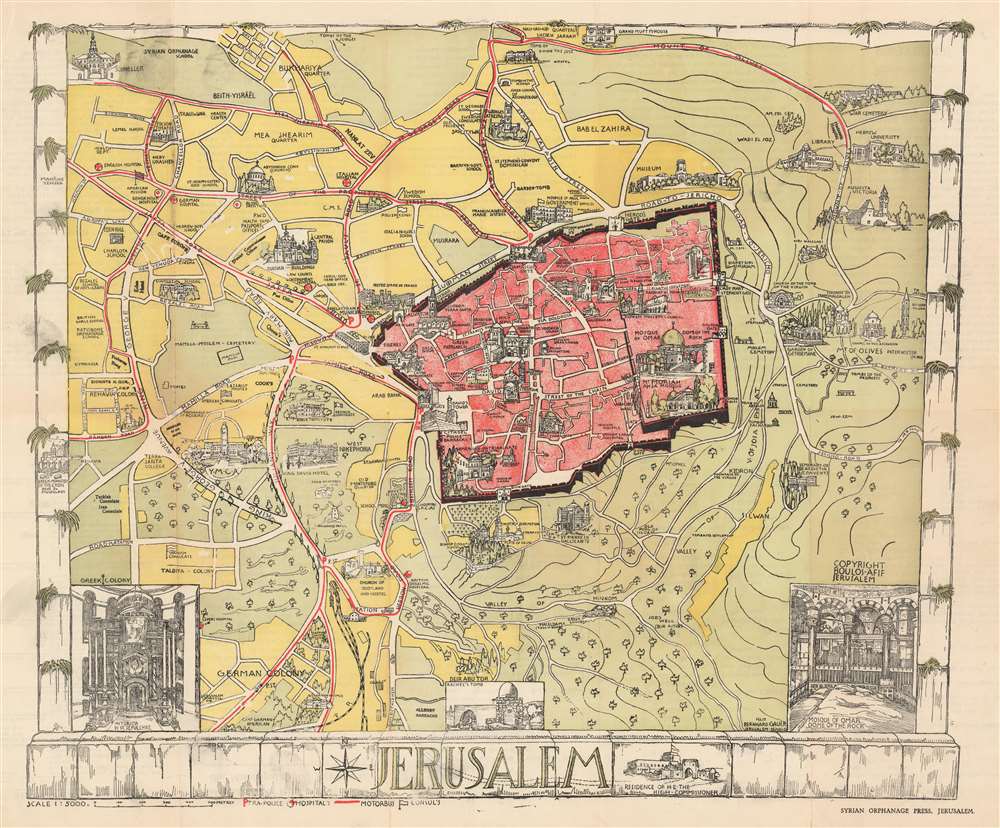
This item below is out of stock, but another example (left) is available. To view the available item, click "Details."
Details
1935 Gauer Pictorial Map of Jerusalem, Israel
$250.00
1935 Gauer Pictorial Map of Jerusalem, Israel
Jerusalem-gauer-1935-2
Title
1935 (undated) 17.5 x 21.5 in (44.45 x 54.61 cm) 1 : 5000
Description
The Schneller Orphanage or Syrian Orphange
This map was printed on the presses of the Schneller or Syrian Orphanage - featured prominently in the upper left corner. The Syrian Orphanage operated in Jerusalem from 1860 to 1940. It was founded by the German Lutheran missionary Johann Ludwig Schneller (1820 - 1896) after the 1860 Lebanese Druze massacre of Maronite Christians in Lebanon and Syria left thousands of orphans. The orphanage building - depicted here - was the site of Schneller's home, and one of the first major structures build outside of the Old City. The orphanage provided both academic and vocational training to orphaned boys and girls from Palestine, Syria, Egypt, Ethiopia, Armenia, Turkey, Russia, Iran, and Germany, graduating students skilled in such trades as tailoring, shoemaking, engraving, carpentry, metalworking, pottery, painting, printing, farming, and gardening. The orphanage also operated its own printing press and bindery; flour mill and bakery; laundry and clothing-repair service; carpenter shop; pottery factory; tree and plant nursery; and brick and tile factory. Located on high ground and surrounded by a high stone wall, the orphanage's distinctive onion-dome tower, multistory buildings, and decorative facades exuded the power and influence of European Christians in mid-19th century Jerusalem. The orphanage continued to operated until World War II, when the British shut it down and deported its German teachers. The British turned the compound into a closed military camp known as the Schneller Barracks.Chromolithography
Chromolithography is a color lithographic technique developed in the mid-19th century. The process involved using multiple lithographic stones, one for each color, to yield a rich composite effect. Oftentimes, the process would start with a black basecoat upon which subsequent colors were layered. Some chromolithographs used 30 or more separate lithographic stones to achieve the desired effect. Chromolithograph color could also be effectively blended for even more dramatic results. The process became extremely popular in the late 19th and early 20th centuries when it emerged as the dominant method of color printing. The vivid color chromolithography produced made it exceptionally effective for advertising and propaganda imagery.Publication History and Census
This map was drawn by the German-Jewish artist Bernhard Gauer. It was published by the Arab publisher Boulos 'Afif, and printed by the Syrian Orphanage Press, Jerusalem. Uncommon.CartographerS
Bernhard Gauer (May 19, 1882 – 1955) was a German painter and mosaic artist. Born in Trier, Gauer attended the Munich Academy and studied under Carol von Marr and Eduard von Gebhardt and then continued his studies in Italy. Eventually, he settled in Dusseldorf and joined the Malkasten artist association. He then served as the chairman of the Association of Dussedorf Artists after World War II. Gauer created stained glass and mosaics in several churches. More by this mapmaker...
Boulos (Mahmoud Sayess) Afif (1905 - c. 1960) was an Arab photographer, illustrator, and publisher based in Jerusalem in the first half of the 20th century. Learn More...

